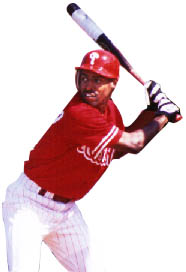
The day after we caught up with Doug Glanville, EAS’92, at the Phillies’ spring-training camp in Clearwater, Fla., The Philadelphia Inquirer ran a story that began: “Lenny Dykstra or Doug Glanville in center? The Phillies’ manager is agonizing over it.” Three days later, the headline read: “Fallout hits Phillies camp,” and an Inquirer columnist was gleefully describing how he had “heard the new kid in town, Doug Glanville, stand at his locker and joke that he’d ruled out trying to resolve this mess by pulling a Tonya Harding.” Actually, that same columnist added, “Glanville has been as patient and rational as a guy could be. He knows that no matter who plays opening day, the future still belongs to him.”
As it turns out, the future is now. By the time Dykstra’s surgically-repaired back finally gave out on him in the third week of March, prompting him to suggest that his retirement was imminent, Glanville had already dazzled his new team with his hitting and fielding. Halfway through the spring-training season, he was hitting a lusty .353 and had made some great catches in center. (“Spectacular,” was the verdict of manager Terry Francona after one running catch. “That’s why we got him. What he can do in center field, we haven’t seen in a while.”)
After a brilliant career at Penn that included a spot on the GTA Academic All-America First Team, Glanville was signed in the first round of the 1991 draft by the Chicago Cubs. He did his time in the minors, riding the buses and learning how to hit the professional curve ball, and after a fair rookie year in 1996, when he hit .241, he turned it up a few notches, hitting .300 last year, stealing 19 bases, and impressing just about everyone with his quick, fluid defense.
Then came the trade, to a team that is not on anyone’s list of pennant-contenders this year. The Phils, in desperate need of a good leadoff hitter and a good glove in center field, gave up one of their most dependable players, second-baseman Mickey Morandini, to get him.
“It’s still a little weird, getting used to being in a new organization,” Glanville was saying over the phone last month. “I feel somewhat in transition. Even if it is Philadelphia, so I’m closer to home” — his parents live in Teaneck, N.J. — “and there are a lot of pluses, it’s still difficult.” But he wasn’t taking his weirdness onto the field — even when he found himself in the middle of a messy situation with Dykstra, a proven crowd-pleaser and clutch hitter who was trying to make a comeback after missing almost two seasons because of a back injury.
“The toughest part is answering questions about Lenny,” Glanville acknowledged. “It’s something I try not to think about, but I have no choice. It’s a tough situation. I just try to control what I do.”
The rational approach is not surprising — Glanville’s father is a psychiatrist — but it has paid off. As another Inquirer reporter wrote, Glanville handled the “Dykstra soap opera with poise, diplomacy, and respect. Sometimes you wondered whether his Penn degree was in international relations instead of engineering.”
Glanville, whose senior engineering project was a transportation-feasibility study for a proposed baseball stadium on the site of the Philadelphia post office at 30th Street, has always made sure that he had a backup plan in case his baseball dream got interrupted. And he acknowledges that some of the mystique of the Show has worn off, as it does for most professional athletes. But right now, you might say that he’s sitting in the catbird seat. The money is, shall we say, not bad. He’s going to be playing every day. And he still loves the competition — and the satisfaction that comes from knowing that “you’re playing against the best, and can compete on that level.”

